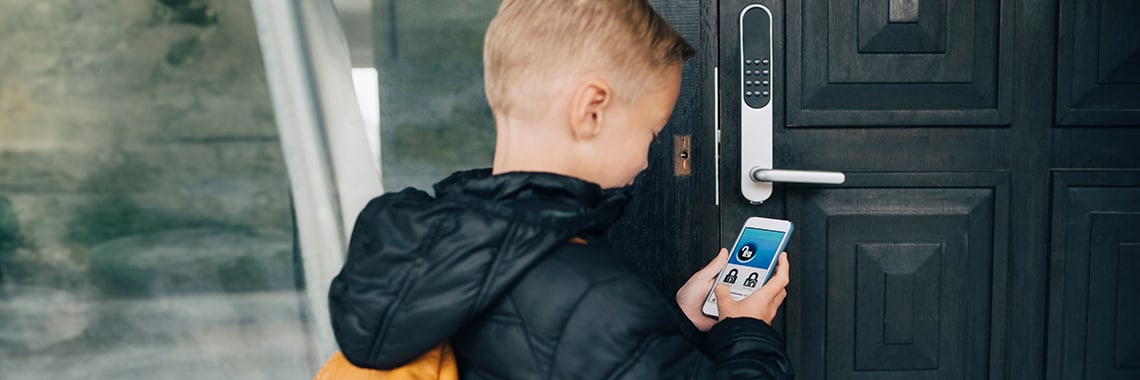Imagine walking into your living room and your phone displays the lighting,
temperature and TV settings for the living room. When you leave and walk
into your bedroom, your phone automatically displays the smart device
settings for the bedroom.
This can all be possible if your devices know, securely and precisely, your location in the
home or building based on your smartphone.
In addition to enhancing
experiences for convenience, channel sounding can be used to enable energy
management. For example, NXP’s channel sounding demo from Embedded World shows how an air conditioner could use channel sounding
to automatically turn on or off. With future generations of the Bluetooth
LE standard, this “locationing” capability may become as ubiquitous as
Bluetooth through a technology called channel sounding¹.
Distance Measurement Isn't New
The idea of using Bluetooth to estimate distance is not new and there have
been several different technologies introduced for this purpose. Shortly after the Bluetooth standard was introduced, the concept
of using the received signal strength (RSSI) was used to get a rough
estimate of distance (see Figure 1). While simple and supported by every
Bluetooth radio, RSSI has many downsides, including very limited accuracy
and security vulnerabilities. Using multiple antennas, Angle of
Arrival/Angle of Departure (AoA/AoD) improves the accuracy limitations of
RSSI, as shown in Figure 2, but does not address the security
vulnerabilities. However, the antennas must be precisely designed and
deployed for AoA/AoD to work correctly, making them both expensive and
difficult to manufacture. Tolerances in the antenna locations on the end
product must be very tight, as any misalignment will decrease the accuracy.
Finally, signal strength measurements for both RSSI, AoA and AoD can be
impacted by signals bouncing off walls and objects. Because of the
limitations of these two methods, the Bluetooth SIG started investigating
an alternative called channel sounding.
 Figure 1 – Received signal strength (RSSI) uses the strength of the
received signal to estimate distance
Figure 1 – Received signal strength (RSSI) uses the strength of the
received signal to estimate distance
 Figure 2 – Angle of arrival/angle of departure uses an antenna array to
estimate distance
Figure 2 – Angle of arrival/angle of departure uses an antenna array to
estimate distance
Distance measurements made with RSSI, AoA and AoD are highly susceptible
to “man-in-the-middle” attacks. Since these methods rely entirely on the
signal strength to estimate distance, if an attacker is able to boost the
signal, then the receiving device will measure a strong signal and estimate
a much closer distance, as shown in Figure 3. This poses a significant
issue for applications like door locks, where the attacker could get the
door to unlock before the end user is close to the door. For example, in a
commercial building an attacker could gain access to the building while an
employee is leaving their car in the parking lot.
 Figure 3 – a “man-in-the-middle” attack with the attacker boosting the
transmitter signal
Figure 3 – a “man-in-the-middle” attack with the attacker boosting the
transmitter signal
Bring channel sounding to life. Learn more about the
MCX W72, NXP's first wireless MCU with Bluetooth channel sounding.
An Enhanced Distance Measurement Method
Channel sounding will be a secure, accurate standard for estimating
distance using Bluetooth LE. Channel sounding combines two different
ranging techniques into the standard Bluetooth LE data flow, time of flight
(ToF) and round-trip phase (RTP), as shown in Figure 4. The initiator sends
a ToF packet to the reflector, which then replies with a ToF packet
indicating when it received the initial communication. Using the speed of
light, the initiator can get a secure, rough distance estimation. Next the
initiator sends a series of tones to the reflector, which sends the tones
back to the initiator. The phase shift in these tones provides a more
accurate distance measurement. Using these two techniques, channel sounding
can achieve open air accuracies of +/- 0.5 meters, providing a secure,
accurate way to measure the distance between two Bluetooth LE devices.
Channel sounding also makes great improvements to security which address
the “man-in-the-middle” attacks deployed with existing technology. This is
accomplished by using encrypted, time-stamped packets in the distance
estimation, which are not reproducible by an attacker. Furthermore,
channel sounding compares the ToF and RTP measurements to ensure both are
similar. With these techniques, channel sounding builds a strong foundation
for robust security.
 Figure 4 – Channel Sounding Procedure Methods
Figure 4 – Channel Sounding Procedure Methods
Channel sounding will bring many benefits to locationing with Bluetooth, and many silicon vendors, including NXP, have already added support to their
chipsets. The initiator and reflector devices must both support the channel
sounding feature, and with smart phones quickly adopting sounding, the feature will soon become common place.
Implementing Channel Sounding with NXP
The ToF and RTP distance estimation algorithms are computationally
intensive and can quickly overburden the core of a typical Bluetooth MCU. To
help developers bring products with “locationing” capabilities to market
faster, the newly introduced MCX W72 wireless MCU family
will support the new Bluetooth channel sounding standard. The MCX W72
family includes a localization compute engine that reduces the latency and
performance burden of the distance estimation algorithm. The MCX W72 is a
secure, flexible and robust multi-protocol wireless MCU family that
supports Matter with Thread, Zigbee and Bluetooth LE and is targeted for
building automation, smart home and other wirelessly connected devices. A
block diagram showing the full feature set of the MCX W72 including the
localization compute engine is shown in Figure 3.
 Figure 5 – MCXW 72 block diagram with Localization Compute Engine (LCE)
Figure 5 – MCXW 72 block diagram with Localization Compute Engine (LCE)
For a better experience, download the
block diagram.
Setting the Stage for Innovation
The security and accuracy introduced by Bluetooth channel sounding opens
the door to many new and innovative Industrial and IoT applications,
especially when combined with other technologies like ultra-wide band (UWB).
UWB utilizes short pulses over a wide frequency band for short range,
secure and precise distance measurement, often achieving centimeters of
accuracy. By combining the two technologies the overall user experience can
be greatly enhanced. For example, a car could use Bluetooth channel
sounding to securely and accurately do longer distance, coarser ranging and
then turn the UWB radio on once the use is close to the vehicle. This
technique allows the UWB radios to stay powered off longer, saving power on
both the vehicle and the user’s smartphone. The new Aliro standard for
smart door locks combines Bluetooth RSSI ranging with UWB, setting the
stage for future innovations with Bluetooth channel sounding. NXP’s Trimension® portfolio of ultra-wideband (UWB) secure radar and fine ranging products, combined
with the newly introduced MCX W72 wireless microcontroller, offer a
complete platform for locationing designs.
Bluetooth channel sounding represents an exciting new chapter for Bluetooth
and for locationing as a technology. With major smartphone chipset vendors
announcing support for channel sounding, soon many new smart phones will
include Bluetooth channel sounding, and with it the ability to accurately
and securely measure distance. With this capability, the opportunities for
innovative IoT applications are numerous—door locks and car keys will be
just the beginning.
¹ The Bluetooth SIG is developing the Channel sounding technology which is based on a working draft of a potential Bluetooth Specification that is subject to change. Bluetooth SIG is targeted 2H2024 for releasing a ratified version of the specification that will include channel sounding.






